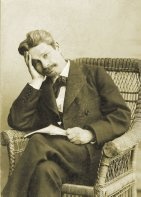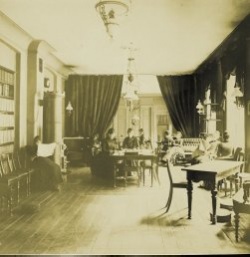Selma Lagerlöf's Danish Breakthrough
20. Nov. 2008

Georg Brandes, the leading literary critic in the Nordic countries at the time when Selma Lagerlöf wrote her first novel. Photo: Courtesy of Det kongelige Bibliotek.
„I Would Need an Opinion"
„Doctor Georg Brandes! [...] Please forgive a poor novice who is presently filled with wonder and disquietude that she is turning to you with the respectful request that you will bestow a bit of your attention on a newly published book, Gösta Berling's Saga [...]. I have already received birching and praise from many sides, but the evaluations I have heard are most contradictory [...]. I would need an opinion from you best of all! [...]," thus wrote Selma Lagerlöf on 21st December 1891 to the Danish literary critic Georg Brandes (1842-1927) in an attempt to find an explanation of the lack of interest in her newly published book. At that time, however, she received no reply from the leading literary critic of the Nordic countries.
„I Thank You Cordially, Miss"
It was a group of women from Female Readers' Association in Copenhagen who instigated the Danish connection to Selma Lagerlöf. Sophie Alberti (1846-1947), president of Female Readers' Association, and literary historian Ida Falbe-Hansen (1849-1922) made a great effort to have Gösta Berling's Saga published in Danish. Together with the stenographer and suffragette Elisabeth Grundtvig (1856-1945) they introduced the Swedish writer in Female Readers' Association which was primarily a library established with the purpose of facilitating women's access to knowledge. Moreover, the women promoted her in the publishing world and to a broader Danish public with the translation of Gösta Berling's Saga in 1892. Nevertheless, it was not enough to arouse the Danes' interest in the novel.

The reading room of Female Readers' Association, Amagertorv in Copenhagen. Photo: Courtesy of Det kongelige Bibliotek.
The Open Door
However, a remarkable review by the very Georg Brandes changed the situation. On the initiative of her Danish colleagues Selma Lagerlöf turned to him once more and this time she managed to arrange a meeting. A few days later, on 16th January 1893, the front page of the newspaper Politiken featured Brandes' review: "With her first work, Gösta Berling's Saga, Miss Selma Lagerlöf has come to the forefront of Swedish literature, struck a new and independent tone. Her novel is distinguished by the rarest and most decisive literary quality, the authenticity of style." With his review, which was, however, not entirely commendatory, Brandes opened the door for Selma Lagerlöf to both the Danish and Swedish public.
In the narrative "The Door that was opened. A Memory of Brandes" from 1933 Selma Lagerlöf is stating: „The helping hand from Brandes opened the door of recognition for me, and not only in Denmark. It had even influence on my position in Sweden [...] The difference between the time before and after was under all circumstances so evident that I shall for ever regard Georg Brandes as one of the persons who primarily made way for me, and I feel that I owe him a debt of gratitude which I can never repay."
This article may be copied or quoted with MuseumsPosten, Post & Tele Museum as source.
Comment this article
Only serious and factual comments will be published.